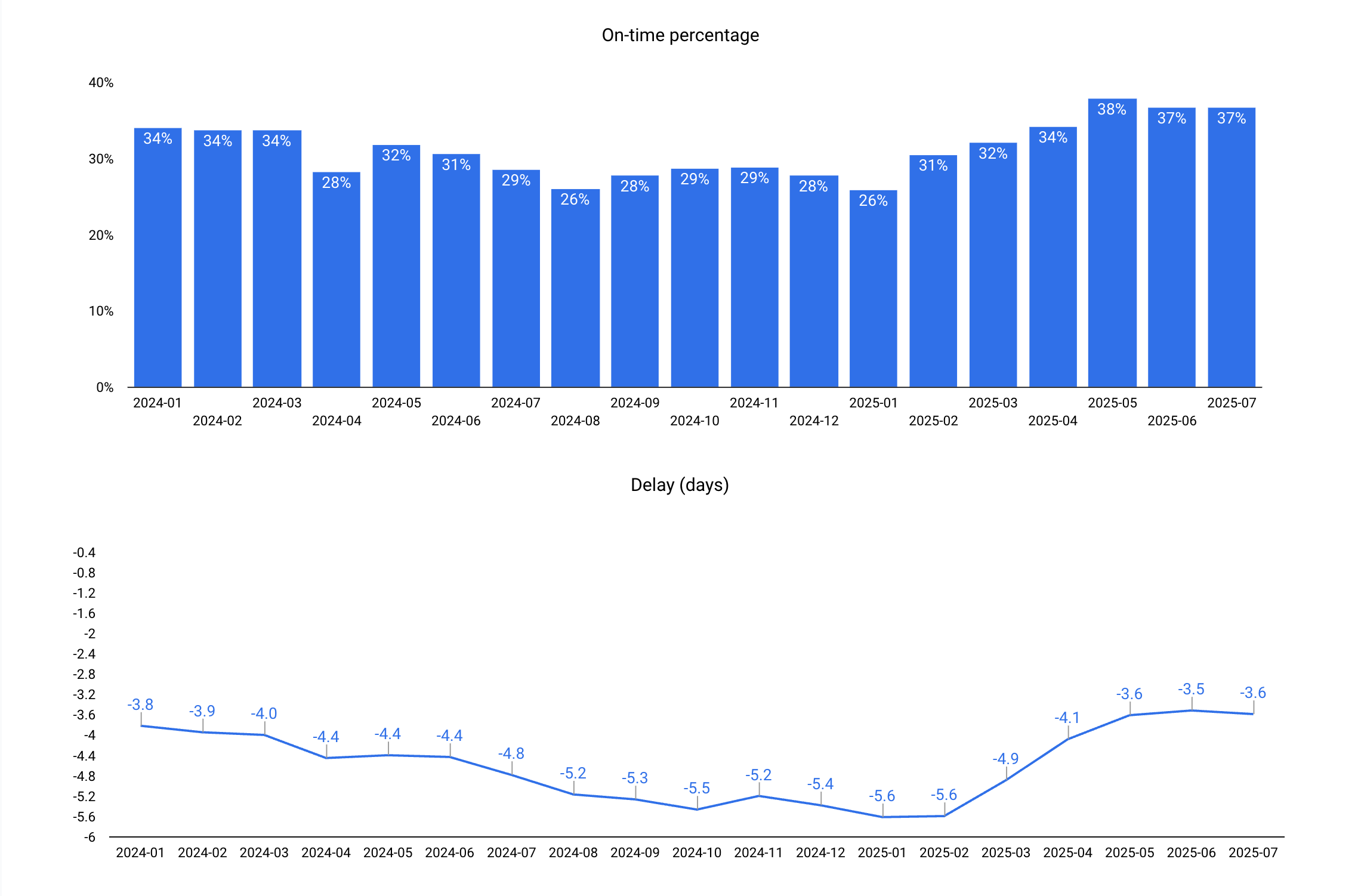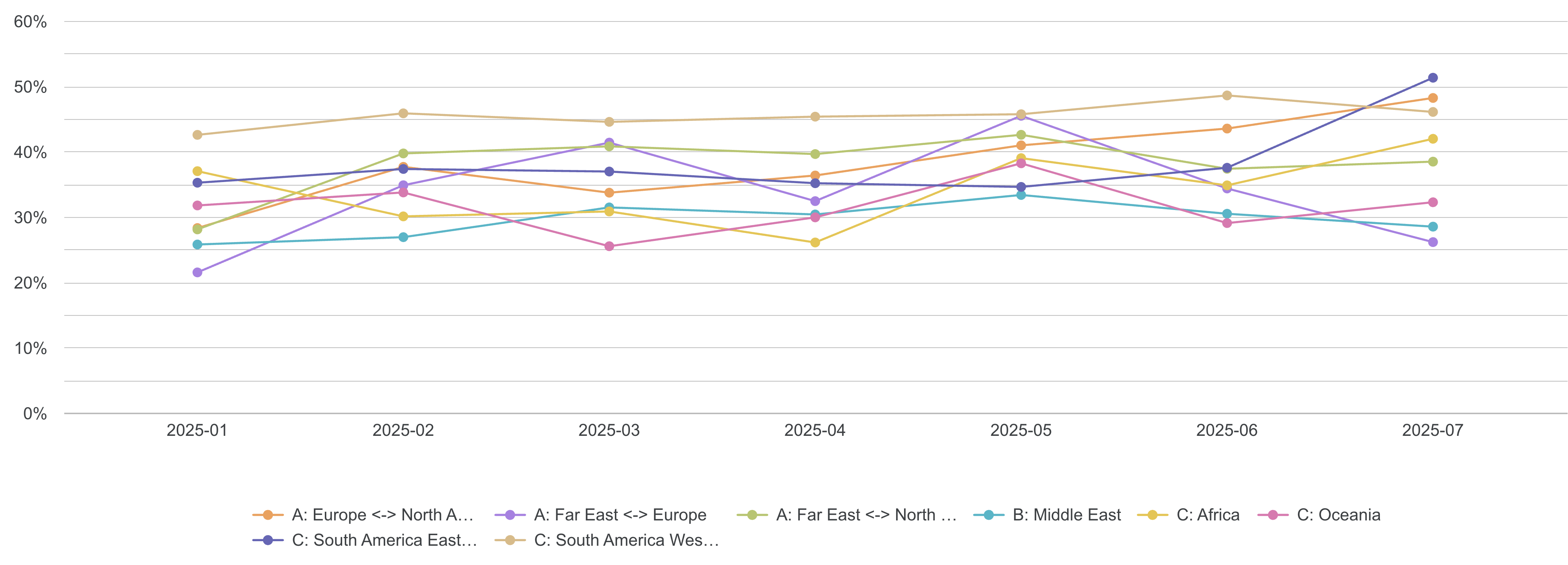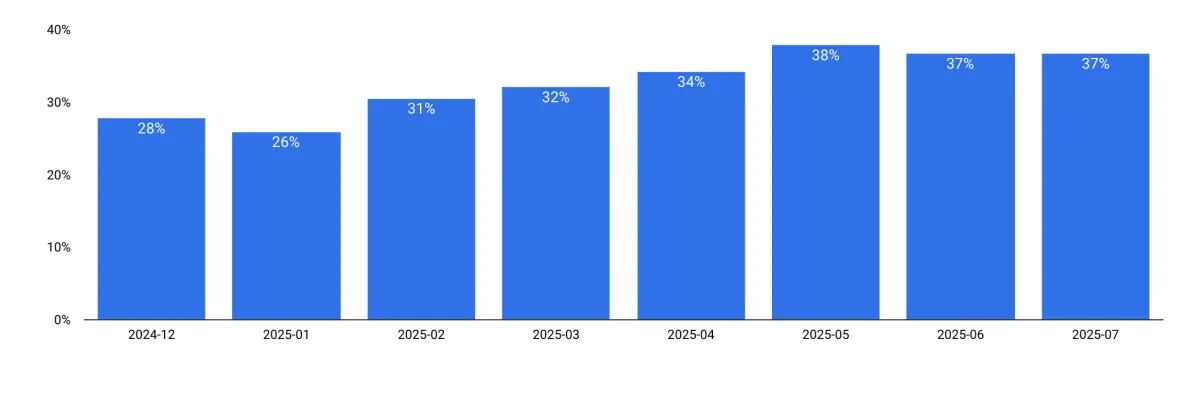Welcome to eeSea's monthly global schedule reliability update, where we examine how the latest geopolitical events and market conditions are critically impacting on-time performance across trades, alliances, and carriers.
Highlights
- The past 4 months have finally brought global reliability out of the slump mimicking pandemic era decline, closing out at 37% in July.
- Gemini is still leaps and bounds ahead of other alliances but not performing equally well across all trades, they're down to 74% in Far East - Europe.
- East Coast South America’s slow and steady comeback sees it leading among trades for the first time since June 2024.
Global
Global reliability has remained stable since the beginning of Q2, with levels peaking at 38% in May and holding steady at 37% in June and July. The stark downward trajectory of average delays that reached pandemic levels in Q3 (-5.1 days) and Q4 (-5.3 days) of 2024 have since been restored to -3.6 days. These are the healthiest metrics since Q4 2023, before a trend of sharp decline took over the following year.
Monthly global reliability

Trade
Far East - Europe is currently experiencing the worst trade reliability at 26% OTP. This is its third lowest monthly reliability of the past two years, coming in after January 2023 (17%) and January 2025 (21%). The on-again-off-again prospect of Red Sea passage coupled with longer transit times and waves of persistent congestion in Europe’s most active hubs necessitate high flexibility from carrier schedules and come at the cost of on-time performance.
Monthly trade reliability

On a positive note, East Coast South America has been on a steady rebound since the beginning of Q3 2024 and finally pushed its way into first place with 51% OTP in July. It also outdid its historically best-performing sister trade of West Coast South America, which dropped to third in the rankings at 46% for the first time since December 2024. Stable performance for both South American trades bodes well for the projected growth in investment from trade partners like China that is stemming from the United States' tariff turmoil.
Alliances
Gemini Cooperation continues to lead alliance reliability at 84% OTP but is not performing equally among all trades. The graph below illustrates an average 74% reliability on Far East - Europe in 2025; highlighting that while it has proven incredibly resilient, the hub and spoke model is not impervious to the effects of market volatility. Gemini’s best performance is on the stable Europe - North America trade, where they allocated 12% of alliance capacity in Q2 and maintained above 90% reliability throughout June and July.
Gemini Cooperation monthly reliability details

Premier Alliance monthly reliability details

On the opposite end of the spectrum, Premier Alliance has the worst performance amongst its peers at 21% this past month, a dip from the 25% Q2 average. Premier has witnessed a relentless month-over-month decline since its launch, due in part to the fact that their dominance lies in the E/W trade plagued with a host of reliability issues. In Q2, 75% of Premier Alliance’s total capacity was committed to Far East - Europe, and 21% reserved for the Transpacific.
Quarterly alliance reliability

While they are still far from approaching Gemini level reliability, non-alliance services and the MSC network are both showing consistent quarterly improvement since January 2025, closing out July at 40% and 28% OTP respectively.
Carriers
Maersk continues to lead the way in carrier reliability in July at 65% OTP, followed closely by partner Hapag-Lloyd at 59%. The Gemini partnership has successfully pulled Hapag-Lloyd out of the middle rungs of the rankings where they oscillated between fourth and sixth place throughout 2024.
Weekly carrier reliability

Absent any alliance ties this year, ZIM has still managed to bump its way into third place in June and July, and sits at 44% OTP this month. Despite CMA CGM seeing their lowest performance since July 2022 this past March and April at 27%, they made a rapid recovery to 36% and land in fourth place in July.
For more insights from the eeSea team please follow us on our Linkedin, visit our News & Analytics page, or reach out to us at data@eesea.com.

